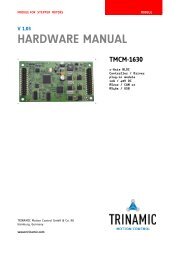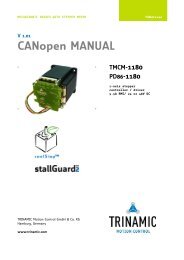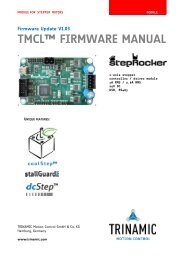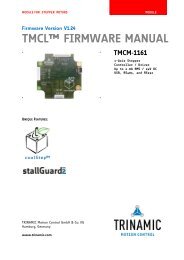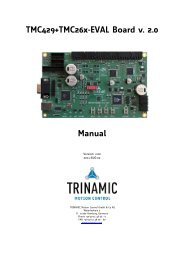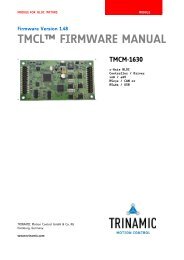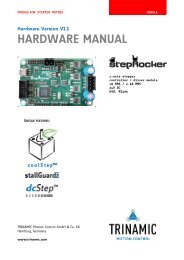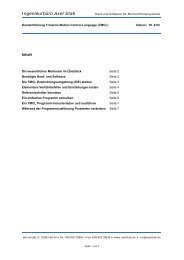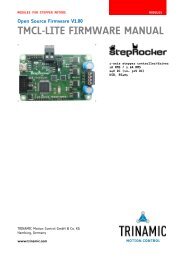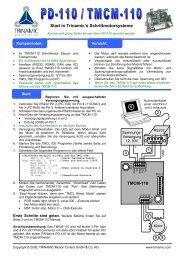TMC428 – Application Note - Trinamic
TMC428 – Application Note - Trinamic
TMC428 – Application Note - Trinamic
You also want an ePaper? Increase the reach of your titles
YUMPU automatically turns print PDFs into web optimized ePapers that Google loves.
<strong>TMC428</strong> <strong>–</strong> <strong>Application</strong> <strong>Note</strong> <strong>–</strong> <strong>TMC428</strong> Getting Started <strong>–</strong> Including StallGuard TM 7<br />
(v. 2.00 / April 14, 2008)<br />
2.2.1.2 Choosing Step Velocities v_min and v_max and the Step Acceleration a_max<br />
The v_min parameter should be set to 1 (please refer the <strong>TMC428</strong> data sheet for details). The v_max<br />
parameter determines the maximum velocity and has to be set depending on the application. Once set,<br />
the a_max parameter can be left untouched for many applications. Change of the parameter a_max<br />
requires recalculation of p_mul and p_div.<br />
If the parameters pulse_div and ramp_div are equal, the parameter a_max can be set to any value<br />
within the range of 0 … 2047. If the parameters pulse_div and ramp_div differ, the limits<br />
a_max_lower_limit and a_max_upper_limit have to be checked (please refer to the TMC datasheet<br />
for details). The velocity does not change with a_max = 0.<br />
2.2.1.3 Calculate p_mul & p_div for a Chosen Set of Parameters<br />
Two parameters named p_mul and p_div have to be calculated for positioning in RAMP_MODE.<br />
These parameters depend on pulse_div, ramp_div, and a_max. So, they have to be determined for a<br />
set of pulse_div, ramp_div, a_max. The parameters p_mul and p_div have to be recalculated if one<br />
of the parameters pulse_div, ramp_div, a_max changes.<br />
An example for calculation of p_mul and p_div for the <strong>TMC428</strong> is given as a C program included<br />
within the <strong>TMC428</strong> datasheet. This C program source code can be copied directly out of the PDF<br />
document. Additionally, a spread sheet named tmc428_pmulpdiv.xls demonstrating the calculation<br />
of pmul and pdiv is available on www.trinamic.com for download.<br />
The principle of calculation of p_mul and p_div is simple: The routine CalcPMulPDiv(...) gets the<br />
parameters a_max, ramp_div, pulse_div, with a reduction factor p_reduction. With these parameters,<br />
a pmul is calculated for any allowed p_div ranging from 0 to 13. That p_div, that results in a valid<br />
pmul that is in the range of 0 to 127 (resp. p_mul that is in range 128 … 255) selects a valid pair of<br />
p_mul and p_div.<br />
3<br />
1<br />
RRS<br />
0<br />
3<br />
0<br />
2<br />
9<br />
2<br />
8<br />
2<br />
7<br />
ADDRESS<br />
2<br />
6<br />
2<br />
5<br />
smda 1 0 1 0<br />
2<br />
4<br />
RW<br />
2<br />
3<br />
Register ref_conf & rm IDX=%1010 (one for each motor)<br />
2<br />
2<br />
2<br />
1<br />
Copyright © 2005-2008 TRINAMIC Motion Control GmbH & Co. KG<br />
2<br />
0<br />
1<br />
9<br />
1<br />
8<br />
1<br />
7<br />
latched position<br />
(waiting)<br />
1<br />
6<br />
1<br />
5<br />
1<br />
4<br />
1<br />
3<br />
1<br />
2<br />
1<br />
1<br />
DATA<br />
1<br />
0<br />
9 8 7 6 5 4 3 2 1 0<br />
lp ref_conf rm<br />
0 0 0 1 0 1 0 0 0 0 0 0 0 0 0 0 0 0 0 0 0 0 1 1 0 0 0 0 0 0 0 0<br />
1 4 0 0 0 3 0 0<br />
Figure 3 : REF_CONF & RAMP_MODE Setting for Stepper Motor # 0 (smda = %00)<br />
REF_RnL<br />
SOFT_STOP<br />
DISABLE_STOP_R<br />
DISABLE_STOP_L



